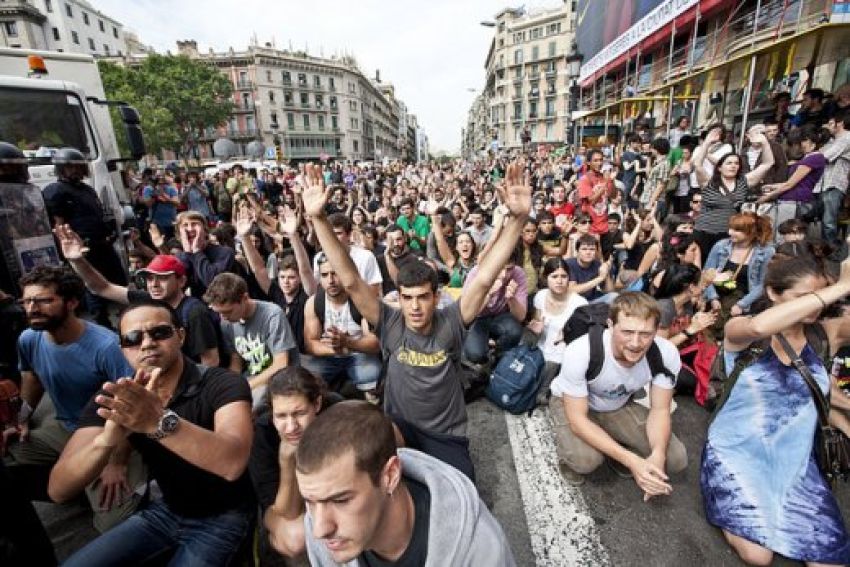
The central plazas of dozens of cities and towns across Spain bear an uncanny resemblance to Tahrir Square in Cairo. They have been taken over by thousands of demonstrators demanding a "new system". As of May 29, dozens of other central plazas in Spanish cities and towns look the same — taken over by thousands of ordinary people demanding “a new system”.
The movement, known as "#spanishrevolution" after the Twitter hashtag used to spread news, pictures and footage of the revolt, began with an internet call for a May 15 protest to demand “Real Democracy Now!”.
Across Spain, more than 100,000 people turned out. In Madrid, protesters decided to establish a permanent camp in the central plaza, the Puerta del Sol.
The protesters — dubbed indignados (the indignant) — were violently attacked, but tens of thousands of people retook the plaza. The plaza occupations spread across Spain, despite the fact that no major unions or political parties have taken part.
The movemetn is driven by anger at the savage austerity imposed by the government of Prime Minister Jose Luis Rodriguez Zapatero from the center-left Spanish Socialist Workers Party (PSOE). Having spent billions of euros bailing out the big banks after the 2008 financial crisis, the government is making ordinary people pay the cost.
Suffering is widespread among Spanish people. The official youth unemployment rate is more than 40%.
This led to the rout of the PSOE in local and regional elections on May 22.
The occupations were originally planned to last until the May 22 poll. But the assembly at Puerta del Sol voted to continue the encampment for at least another week — and to use the plaza as a base to spread the protest movement to neighbourhoods throughout the city.
The strength of the movement was shown when, on May 27, the Catalonian government carried out an ill-fated attack on the occupation of Plaza Catalonia in Barcelona.
Dick Nichols, from the Green Left Weekly European bureau, reports from the scene at Plaza Catalonia.
* * *
Somewhere in this city lives a group of brutal numbskulls called the “government of Catalonia”.
On Thursday, May 26, these people decide that it is time to “clean up” Plaza Catalonia, the big square in the centre of Barcelona where the “indignants” of the #spanishrevolution and Real Democracy Now movement have pitched tents, installed webcams and planted veggie patches.
Early the next day, we awake to the thump-thump of the police helicopter as their operations begin.
It is 6.45am, and 100 police have entered the camp to explain to the disconcerted “indignants” that they had come to clean up the area “for reasons of public health”: the protestors have to leave the area. The protestors refuse, but offer nicely to help with any clean-up.
The police then surround the camp with a double cordon to prevent the support that the protestors had called from entering.
At this point there are 300 campers inside the square, who watch on while council workers started to dismantle the entire camp, taking away everything.
As support arrives it began to surround the outer police cordon, which tries to force people back to the outer edges of the square. When people link arms to oppose passive resistance to this operation, the police begin to attack with truncheons.
Video: Police attack Plaza Catalonia. AJ M.
Video: Vi. deo: Police attack. Europa Press.
The passive resistance continues, and the police attacks intensify, even as the protestors keep up the chant: “We won’t move from Plaza Catalonia.”
The police next try to open space for the council trucks to leave the square, but it keeps filling up with protestors sitting down before the trucks.
The police attacks intensify, especially after 10.15am, when reinforcements arrive to force a way out for the trucks. All this is televised live.
The council trucks finally manage to get out around 11am, and a tense calm returns.
Mission accomplished, so it would seem. Felip Puig, the Catalan interior minister appears before the media to explain that he had reluctantly to bring in 300 riot police to protect Barcelona’s decent garbos from assault by violent weirdo protestors.
For a short time, the square seems to re-open to normal business (tourists taking photos and buying schlock).
Slight hiccup, however. No-one in the Catalan government seems to have heard of things called “Facebook” or “Twitter” (or maybe they think such things only work in Cairo).
Over the next hour supporters of the camp pour in from around Barcelona, so that by 1pm the police can no longer hold the square. They begin to retreat before a crowd now numbered at over 2000 and finally abandon the square.
Video: Triumphant protesters rEuropa Pressetake Plaza Catalonia as riot police are forced into retreat. Europa Press.
Next, at 2.30pm, in solidarity with Plaza Catalonia, students from the University of Barcelona block off the Diagonal, the big avenue that runs across the whole city, generating traffic chaos.
At the same time everyone even vaguely connected with the #spanishrevolution movement starts receiving messages to go to Plaza Catalonia by 7pm --with saucepans and spoons for a cacerolazo (pot banging protest).
Result? By 8.30pm the square is full of up to 10,000 people and the “indignants” are re-establishing their camp. Enormous enthusiasm for victory over the idiots!
Protest gatherings and marches in solidarity with Barcelona (and Lleida, where a similar “clean up” took place) now explode in towns across Catalonia and Spain.
A petition demanding Puig’s resignation has already gathered 10,000 signatures. All the other parties start to criticise the government’s action.
The movement has been given a huge shot in the arm. #spanishrevolution -- 1, Catalan government -- 0.